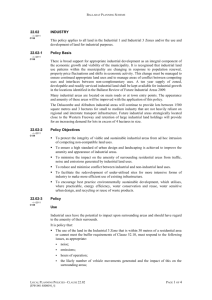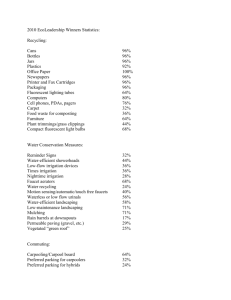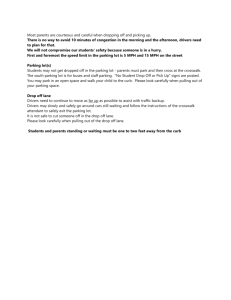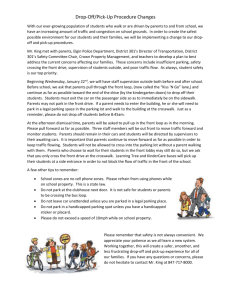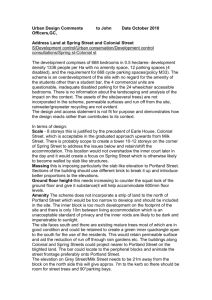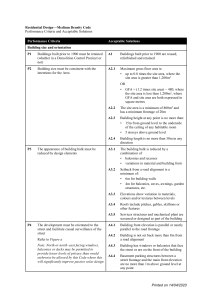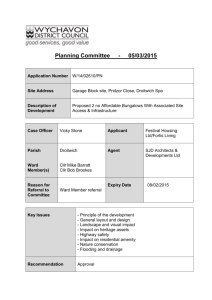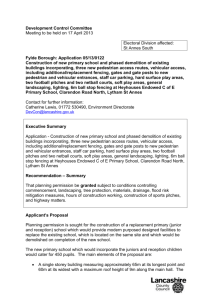049892 Design & Access Statement_A4
advertisement
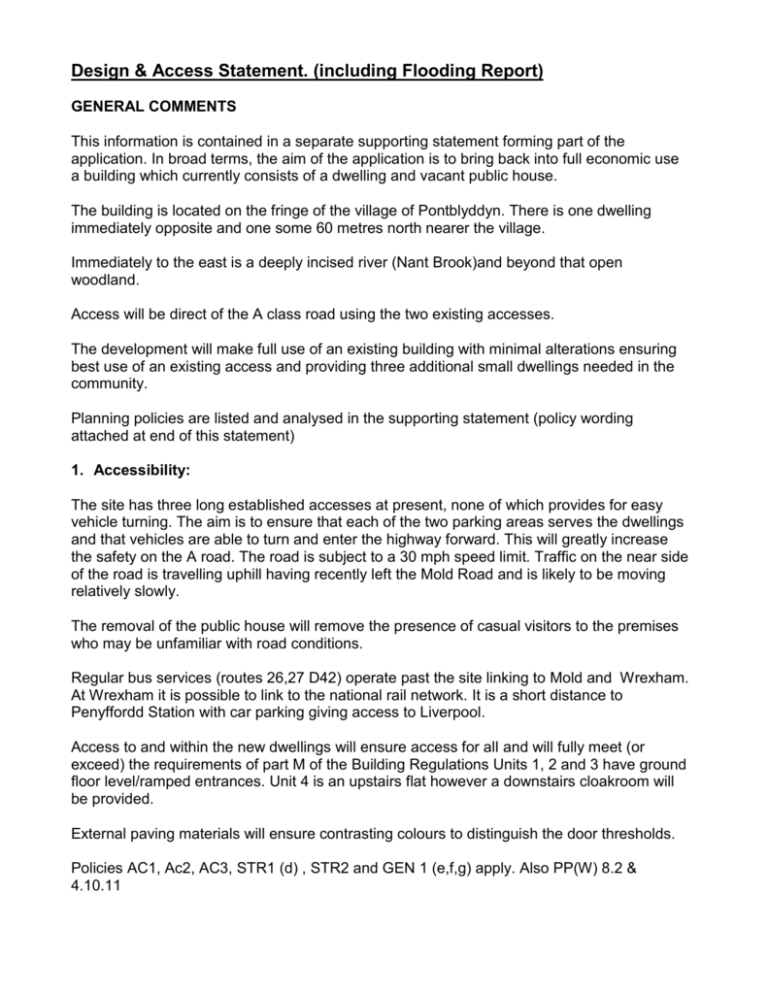
Design & Access Statement. (including Flooding Report) GENERAL COMMENTS This information is contained in a separate supporting statement forming part of the application. In broad terms, the aim of the application is to bring back into full economic use a building which currently consists of a dwelling and vacant public house. The building is located on the fringe of the village of Pontblyddyn. There is one dwelling immediately opposite and one some 60 metres north nearer the village. Immediately to the east is a deeply incised river (Nant Brook)and beyond that open woodland. Access will be direct of the A class road using the two existing accesses. The development will make full use of an existing building with minimal alterations ensuring best use of an existing access and providing three additional small dwellings needed in the community. Planning policies are listed and analysed in the supporting statement (policy wording attached at end of this statement) 1. Accessibility: The site has three long established accesses at present, none of which provides for easy vehicle turning. The aim is to ensure that each of the two parking areas serves the dwellings and that vehicles are able to turn and enter the highway forward. This will greatly increase the safety on the A road. The road is subject to a 30 mph speed limit. Traffic on the near side of the road is travelling uphill having recently left the Mold Road and is likely to be moving relatively slowly. The removal of the public house will remove the presence of casual visitors to the premises who may be unfamiliar with road conditions. Regular bus services (routes 26,27 D42) operate past the site linking to Mold and Wrexham. At Wrexham it is possible to link to the national rail network. It is a short distance to Penyffordd Station with car parking giving access to Liverpool. Access to and within the new dwellings will ensure access for all and will fully meet (or exceed) the requirements of part M of the Building Regulations Units 1, 2 and 3 have ground floor level/ramped entrances. Unit 4 is an upstairs flat however a downstairs cloakroom will be provided. External paving materials will ensure contrasting colours to distinguish the door thresholds. Policies AC1, Ac2, AC3, STR1 (d) , STR2 and GEN 1 (e,f,g) apply. Also PP(W) 8.2 & 4.10.11 2. Environmental Sustainability: The conversion of an existing building reduces the demand for building materials. The conversion will provide for improved thermal insulation to the roofs and walls. The internal services will be completely replaced to meet the best modern standards as far as is practicable and thus energy demands and water consumption will be reduced to minimise carbon emissions. It is intended to meet level 3 Code for Sustainable Homes. Provision will be made to save rain water for use for grey water use or in the garden. The development will consider including showers, twin-flush WC and low energy electrical appliances. Screened areas for external drying washing will be provided. So far is practical, the development will use locally sourced materials to reduce the impacts of the construction . Policy D1(f) , D3, EWP2 apply also PP(W) chapter 4 3. Community safety The development should not cause any issues of community safety. The properties will be clearly visible from the public highway with suitable boundary treatments which will protect privacy and provide for security. The highway is well-lit. There are no hidden areas in the sketch layout where problems could develop. Residents could be encouraged to join a Neighbourhood Watch scheme. (STR1 (c), GEN1 (b) & PP(W) 4.101.2) 4. Character The development will have a very low impact upon the character of the area. The removal of the “New Inn” signs has already reduced the impact. The changes to the external appearance of the building will be almost entirely un-noticeable from outside the site. Some additional landscaping may be possible to soften the impact of parked cars. This will be an improvement to the appearance of the area. (GEN1 & D1, & D3) 5. Movement to, from and within the development Residents will have easy access to public transport. Apart from the fairly gentle gradient on the short section down to the A541, the road to Mold is basically level and suitable for cycling. It would be reasonably easy to cycle to Penyffordd Station to access train services to Wrexham, Shotton or Liverpool. There is adequate space within the site to provide for secure cycle storage if required. Car parking will be provided within the site to meet Council maximum standards. It will all be close to the entrance doors and on the same level. Gradients within the site will be minimised to ease access for disabled persons or for mothers with children. (AC2, AC3 AC18,STR2, PP(W) 4.10.11) Conclusion: Development of the site meets all the requirements of a sustainable development which will provide much needed small dwellings in the community. It will enhance the amenity of the area through bringing back into use the whole building using sensitive design principles. Flooding Consequences Report The Environment Agency flood map is difficult to interpret at a scale which allows appropriate understanding of the possible flood position. A site visit will demonstrate quite clearly the position. To the best of our knowledge, the building has never flooded and the stream is many metres below the ground level of the property. Because of the slope of the stream bed any flood would dissipate very quickly. Any flood water which might possibly be diverted higher up the valley and coming down the road would pass by the site quickly without impacting upon the residents. There is no perceptible flood risk. Robert A Dewey MRTPI. Bobdeweyplanning. June 2nd 2012. FLINTSHIRE UDP adopted Policies STR1 New Development New development will be: a. generally located within existing settlement boundaries, allocations, development zones, principal employment areas and suitable brownfield sites and will only be permitted outside these areas where it is essential to have an open countryside location; b. required to incorporate high standards of design which are appropriate to the building, site and locality, maximise the efficient use of resources, minimise the use of non-renewable resources and minimise the generation of waste and pollution; c. required to create a safe, healthy and secure environment and protect standards of residential and other amenity; d. required to respect community identity and social cohesion including the adequacy and accessibility of community facilities and services; STR2 Transport and Communications In order to facilitate a safe, efficient and integrated transport and communications system and improve accessibility throughout the County, new Development will be expected to incorporate, wherever practicable, the following requirements: a. minimising the number and length of journeys especially by private car; b. making the best use of existing road and addressing congestion and safety issues through traffic management and calming measures; c. enabling the efficient use of and improvements to public transport; d. enabling alternative means of travel including cycling and walking; GEN1 General Requirements for Development Development that requires planning permission and is in accordance with the Plan’s other policies, should be located on land, or within suitable buildings, which satisfies the following requirements: a. the development should harmonise with the site and surroundings in terms of the siting, scale, design, layout, use of space, materials, external appearance and landscaping; b. the development should take account of personal and community safety and security in the design and layout of development and public/private spaces; c. the development should not have a significant adverse impact on recognised wildlife species and habitats, woodlands, other landscape features, townscapes, built heritage, features of archaeological interest, nor the general natural and historic environment; d. the development should not have a significant adverse impact on the safety and amenity of nearby residents, other users of nearby land/property, or the community in general, through increased activity, disturbance, noise, dust, vibration, hazard, or the adverse effects of pollution; e. the development should provide, where appropriate, safe and convenient access for pedestrians, cyclists, persons with disabilities, and vehicles, together with adequate and suitably located parking spaces and servicing/manoeuvring space; f. the development should not have an unacceptable effect on the highway network as a result of problems arising from traffic generation, and should incorporate traffic calming measures where appropriate; g. the development should have, where appropriate, convenient access to public transport, and wherever possible is well related to pedestrian and cycle routes; h. the development must have regard to the adequacy of existing public services (e.g. gas, water, electricity), with new infrastructure capable of being provided in reasonable time and at minimum public cost; i. the development should not result in/be susceptible to problems related to drainage, land stability, contamination, or flooding, either on or off site; D1 Design Quality, Location and Layout All development must incorporate good standards of design. Development will be permitted only if: a. it respects the scale of surrounding development, its location, siting, and layout make the best use of land, minimise the need to travel, and provide a safe and attractive environment; c. it relates well to local topography, aspect, microclimate, street pattern, orientation and views; d. it creates positive and attractive building alignments and frontages; e. adequate provision is made for space around buildings, setting of buildings, imaginative parking and landscaping solutions; f. maximises the efficient use of resources, minimises the use of non renewable resources and minimises the generation of waste and pollution g. it is accompanied by design information commensurate with the scale and type of development proposed D2 Design Development will be permitted only where: a. the proposed building and structures are of a good standard of design, form, scale and materials; and b. it protects the character and amenity of the locality and adds to the quality and distinctiveness of the local area. D3 Landscaping New development will be required, where appropriate, to include a hard and soft landscaping scheme which considers:a. landscape or townscape character of the locality; b. the topography of the site; c. aspect, microclimate and soil type; d. existing man-made and natural features; e. existing trees and vegetation; f. use of indigenous species and materials; g. appropriate boundary treatment; and h. nature conservation interests. AC1 Facilities for the Disabled Development proposals will be permitted only if appropriate facilities are provided to meet the special needs of people with disabilities. AC2 Pedestrian Provision and Public Rights of Way Development proposals will be permitted only where: a. there is safe, direct, and overlooked foot access to main local pedestrian routes AC3 Cycling Provision New development proposals will be required where appropriate, to provide: a. safe and convenient cycle access to the local highway network or any existing or proposed cycle lane / route in the locality; AC18 Parking Provision and New Development All new development, including changes of use, must provide appropriate parking in accordance with Flintshire County Council Parking Standards, which will be applied as a maximum. 2 Bedroom house 2 car spaces per unit 3 Bedroom house 3 car spaces per unit Flats 1 car spaces per unit + 1 car space per 2 units for visitors EWP2 Energy Efficiency in New Development In all new development the Council must be satisfied that sufficient steps have been taken in the siting, aspect, form and design of new buildings to minimise the wasteful consumption of energy and resources both in the construction and use of buildings.
